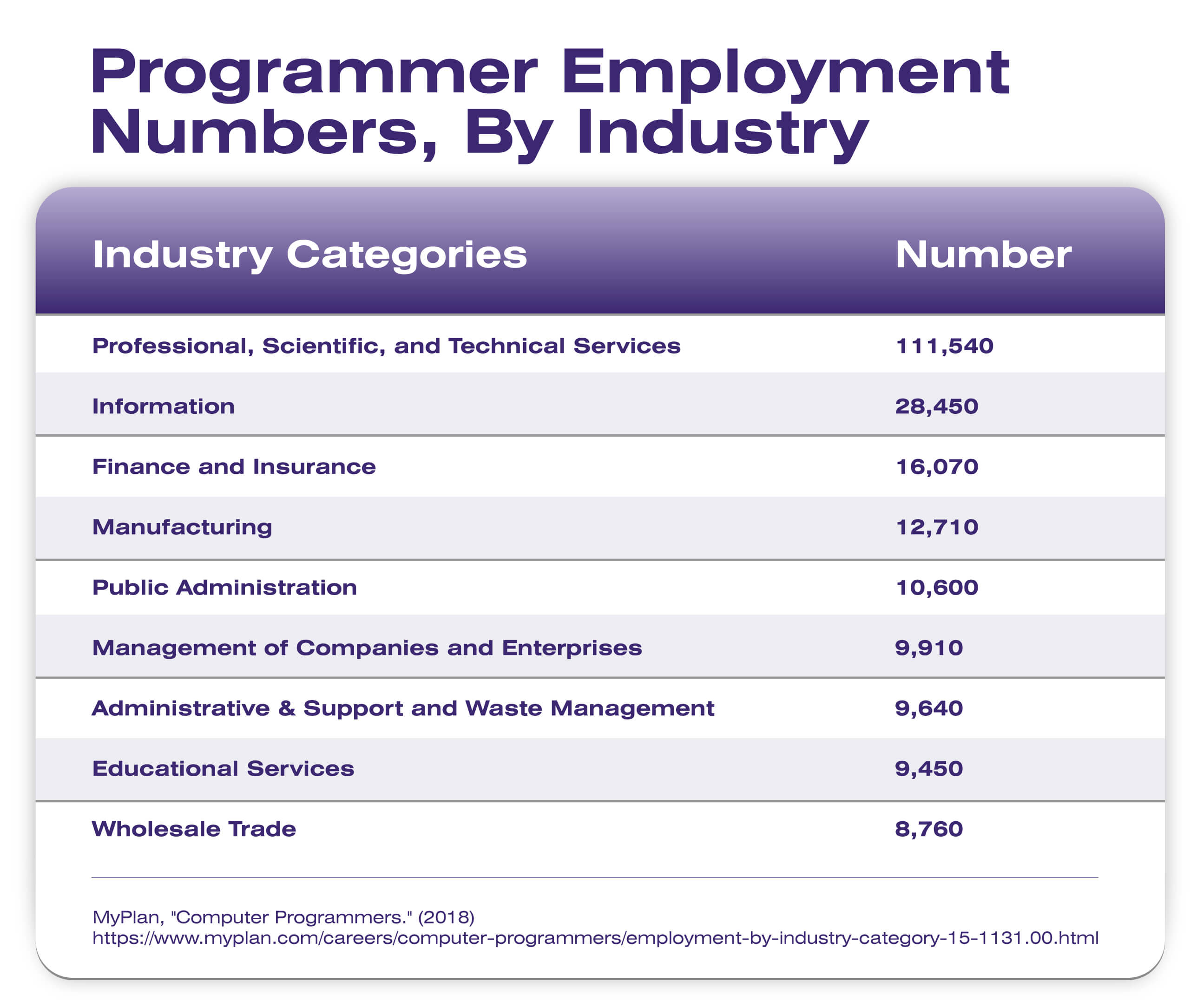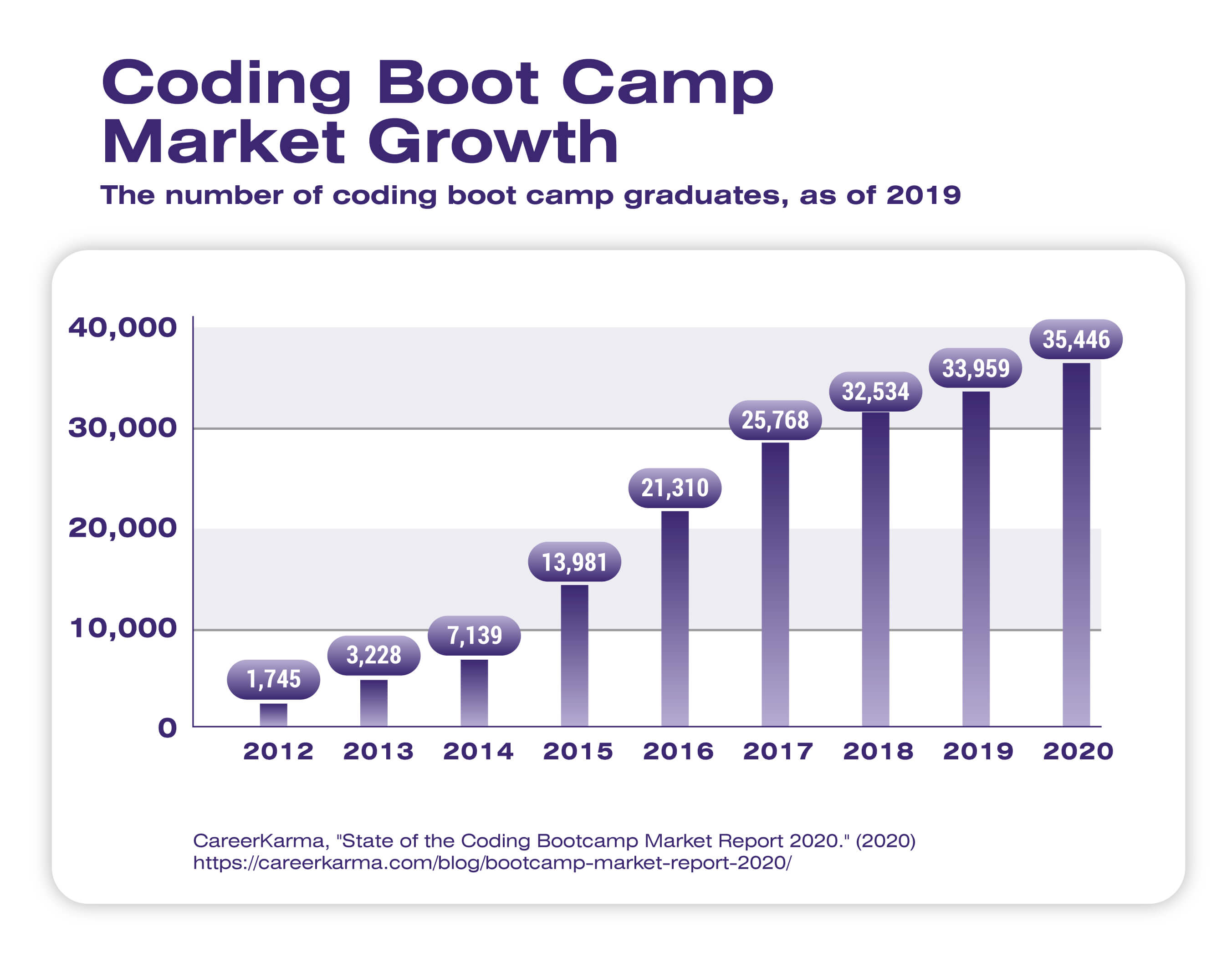How to Become a Programmer: A Step-By-Step Guide

Programmers are, in a sense, digital architects who dedicate their careers to designing the tech features and functionalities we all take for granted. It’s a fantastic profession, and if you’ve ever found yourself thinking about the cogs behind the internet’s not-so-metaphorical machine, you’ve probably wondered how to become a programmer.
Take account of everything you’ve done online so far today. If you’re like most tech-savvy people, you’ve probably checked your email, scrolled through your social media feed, and browsed a few of your favorite websites — perhaps even before breakfast. But have you ever given a thought to the work that went into the virtual platforms that you visit every day?
Believe it or not, each of the websites, apps, and games that you flip through in seconds is the result of hours of programming work.
Programming is a fantastic career path with great potential for growth, especially since so much of our lives are now lived online. The Bureau of Labor Statistics reports that the profession will grow by a full 13 percent between 2018 and 2028 — over twice the average rate of growth expected for all other occupations.
According to Payscale, the majority of programmers feel happy about their success, confident in their skills, and secure about their financial futures; the profession enjoys a 4.5 ranking (out of 5) for satisfaction.
One reason why programmers take such pride in their jobs is that they are responsible — at least in part — for shaping the structures that those in the modern world use to communicate and engage with their communities.
As web design expert Jo Jung once put the matter for The Conversation, “Just as the architectural style of a building reflects the society from which it emerges, so the evolution of web design reflects the changing fashions, beliefs, and technologies of the time.”
Perhaps you, too, want to be a part of that crucial “architectural” development. If so, let’s talk about the steps involved in becoming a programmer:
- Decide Which Industry You’re Interested In
- Identify the Languages You’ll Need to Learn
- Start Learning in College, at a Bootcamp, or Independently
- Start Your Own Projects
- Begin Looking for Jobs
1. Decide Which Industry You’re Interested In
When considering how to become a programmer, your first step should be to determine a general direction for your career path. Think about why you want to become a coder — where do you want to go? What do you want to do or achieve?
While the average layperson might associate programming most with tech, jobs are available in almost every industry. Businesses in every sector need web developers and programmers; a talented coder could find their start in any field from artificial intelligence and cybersecurity to social services, health care, financial services, and even agriculture.
In 2018, researchers for MyPlan broke down employment figures for the top industries employing programmers and revealed a surprising dispersal across sectors.
While 111,540 programmers are employed directly in scientific, technical, and professional services, a not-inconsiderable 28,450 work in information. Another 16,070 work in finance and insurance, 12,710 have a role in manufacturing, and 10,600 in public administration. All of these numbers are expected to grow in the coming decade.

Needless to say, aspiring programmers have career options. It’s good to have a general idea of your desired industry when you start mulling how to become a programmer — although you shouldn’t feel confined to one vision! The skills you develop will be transferable across sectors.
2. Identify the Languages You’ll Need To Learn
With this said, it’s perhaps more helpful to home in on whether you would be interested in programming on the front end or the back end. While many of the same skills underlie both, each category has its own focus and requires a distinct set of skills.
Those who work in front end development are primarily concerned with the portion of a website that users interact with. Front end developers determine a site’s visual appearance, direct its behavior, and deal with its content and structure. Their job is to maximize efficiency, utility, performance, and responsiveness to ensure accessibility to all users.
Back end developers, as you might expect from the name, work behind-the-scenes to address the server side of programming. These developers deal with the libraries, system components, and data structures that users never see firsthand and ensure that a program functions as well as a front end developer makes it look.
Determining a focus will help you figure out which languages and programs to prioritize during your training. In this section, we’ll be focusing on a full stack set of skills that encompass languages relevant to coders who work on both the front and back ends of development.
HTML, CSS, JavaScript
While there are countless languages available to aspiring programmers, all should have at least a basic understanding of the front end trifecta: HTML, CSS, and JavaScript. These three technologies create the frameworks that almost all websites use to define an experience for their users and are thus critical to your future programming career, especially for those seeking to become web developers.
HTML, or HyperText Markup Language, is essentially the framework for any website you visit today. HTML code provides the site’s structure via “tags” that define the essential elements of a web page, from text to links to images and more.
However, when you surf the web, you will find sites that look dramatically different from one another. Much of the magic of web design is made possible through CSS (Cascading Style Sheets). CSS defines and applies styles to a website, determining how nearly every aspect of a site appears to the viewer.
Finally, JavaScript, a runtime language, serves as the driving force behind more interactive websites. When you load a page, you’ll also load JavaScript; that running script allows users to make decisions and perform actions on the site, such as searching a map or making an appointment. JavaScript also lets you create an engaging website by facilitating constant updates and dynamic visitor interactions.
Bootstrap
Bootstrap is a widely used, open-source development framework for front end programming that helps programmers develop responsive websites and applications. It is particularly useful for the development of mobile apps and mobile-first sites — a critically important aspect of web programming, given that more people than ever access the web via their mobile phones.
Node.js/Express.js
Node.js is an accessible open-source environment that provides programmers with a framework to create an array of server-side applications using JavaScript. Node.js is designed for use on the server, rather than in the browser, but uses regular JavaScript, which allows for smoother shifting back and forth between front end and back end tools.
Relatedly, Express.js is the most popular web framework for Node. It allows programmers to manage settings for web applications and process data requests, with a wide range of libraries to handle the diverse needs of interactive websites or apps.
Java
Despite the similarities between their names, back end-centric Java differs significantly from front end-focused JavaScript. Java is a full-fledged, object-oriented programming language with a wide range of applications. Java can create standalone programs, while JavaScript typically must operate within an HTML page. Java is also frequently used for mobile app development.
Both languages, however, play an essential role in developing functional and user-intuitive digital platforms.
Git
Git is a system for version control, an open-source project that many other software projects — including many of the best-known open-source programs and frameworks — rely on to track changes and allow hundreds, or even thousands, of collaborators to participate in shaping significant projects.
Without version control software like Git, programmers working on a joint project might accidentally save over each other’s work and overwrite critical edits.
SQL
SQL, or Structured Query Language, allows developers to manage and edit databases of information. Much of the web relies on extensive databases to facilitate interactivity and fast access to vast quantities of data. SQL is one of the most common languages for database management, and many websites use branded versions of SQL, such as MySQL, to manage data.
Even if you don’t intend to work extensively with databases, you will benefit from developing a strong knowledge base in SQL.
3. Start Learning in College, at a Bootcamp, or Independently
There are countless ways for aspiring programmers to get the skills that they need to become professionally competitive and find a great job; the method that you choose depends on your situation and the resources you have at hand.
You may need to consider how much time you have to dedicate to learning programming skills. If you are just starting your career and have saved up some money, you may opt for full-time study to move more quickly into your new career — but if you have outside obligations or need the income that a full-time job provides, a part-time course of study may be best for you.
There are a wide variety of part- and full-time, in-person, and remote opportunities available to aspiring programmers. Keep your timeline in mind as you chart your path, and check out the below options to pick a learning method that fits your needs.
College
One way to learn how to become a programmer is to pursue a four-year university degree in computer science. In 2019 alone, American colleges and universities awarded 79,598 bachelor’s degrees in computer and information sciences.
Recent reporting from the New York Times found that an uptick of interest in STEM (science, technology, engineering, and mathematics) has prompted a massive influx of students into computer science and related majors. It’s important to remember that while computer programming and computer science majors sound similar, they are different.
As the College Board distinguishes the two: “If you want to concentrate mostly on the theory and design of computer systems, consider a major in computer science. But if you want to dive right into learning the computer languages, like C++ and Java, that run operating systems, networks, and software, [computer programming] could be the major for you.”
Not all colleges and universities offer both degree paths, so it is crucial to investigate the offerings to determine if a particular course of study is right for you. You can, of course, become a programmer with a computer science degree — however, you may need to do some more practical training before you can hit the ground running.
In most cases, this educational option is best for those who haven’t yet completed an undergraduate program and have the time and resources to finish a four-year degree.
Bootcamps
For those who already have an undergraduate degree, or have competing work and family obligations, bootcamps offer a flexible learning experience at a reasonable price. You typically choose a specific program of study, such as full stack development or data science, and dive deep into a guided educational curriculum that focuses on practical programming skills and tools.
People can complete a full-time bootcamp in as little as three or four months, though some bootcamps do run as long as a year. As a result of this quick turnaround, bootcamps have become an increasingly popular way to enter the field. In 2020, CareerKarma’s Market Report noted that the coding bootcamp market grew 4.38 percent in 2019 and produced 33,959 graduates.

Bootcamps are well-suited for those who want a formal, guided education that provides the knowledge necessary to build a programming career in a relatively short period. This learning method can also be an excellent option for those seeking a career pivot or those who want to upskill and become competitive in the tech job market quickly.
Want to kick off your bootcamp research? Check out our coding bootcamp to find out what you could learn.
Independent Learning Platforms
If you don’t have the time to begin a formal program and want to learn more about programming on your own, independent learning programs can allow you to take a more self-directed path to a career in web development. There are countless readily available online tools that you can use to enhance your programming skills, such as tutorials, books, videos, and coding projects.
If you’re interested in a self-directed approach, you may also want to look into free or inexpensive online courses that allow you to set your own pace and progress on your own through the material. Generally, these involve little interaction with the instructor but provide reliable, detailed information to help you learn.
There are pros and cons to self-directed online learning. On the one hand, you can learn to problem-solve, which is an instrumental skill in programming; by learning research skills, you can fix your own code and solve problems on the fly.
On the other hand, any self-directed learning path requires a great deal of discipline, commitment, and time. Because you are accountable only to yourself, you need to set aside the time and do the research to progress on your own. Consider your learning preferences and ability to self-motivate before you commit to this path!
4. Start Your Own Projects
Regardless of the educational avenue you choose, starting your own programming projects is a great way to get experience and develop your skills. You can cite these projects when applying for jobs, and participating in large-scale programming initiatives will empower you to make valuable industry connections.
By writing your own code and publishing it, you can take the theoretical knowledge you learn in a course, at a bootcamp, or in university and transform it into a practical application. You may not realize it now, but a well-stocked portfolio of successful projects demonstrates your skills to employers more clearly than any well-formatted CV ever could.
Working on projects is especially crucial for self-directed learners, given that they may not have as many opportunities to create projects in class as college and bootcamp students typically do.
Some options include:
- Building your own website
- Developing a simple mobile app, such as a weather application
- Recreating one of your favorite apps with your desired upgrades and modifications
What are you interested in building? Here are a few articles to spark your creativity:
- 40 Side Project Ideas for Software Engineers — Codementor
- 10 Great Programming Projects to Improve Your Resume — GitConnected
5. Begin Looking for Jobs
The steps to launching your programming career are similar to those in other fields. You’ll need to create a resume, collect your professional references, and pull together a publicly accessible portfolio. Attending conferences and collective programming events can also help you develop connections and get to know the industry better.
All of the above can help you to get leads, find jobs, and present a great application. You’ll need to practice your interview skills and present yourself well — but remember that programming job interviews also include technical tasks, so get ready to shine when it comes to coding.
The market is hot, but remember that it may take a few months to find a programming job depending on your location and current hiring needs. If you’ve taught yourself to program and are finding it difficult to get hired, you may want to consider enrolling in a bootcamp to boost your resume, appear more marketable, and make valuable connections.
Need help getting started? Here are a few resources to guide your efforts:
- How to Write a Great Resume for Software Engineers — freecodecamp
What’s Next for You?
Programming offers tremendous value as a career, with benefits ranging from upward mobility to job satisfaction.
When considering how to become a coder, think about the educational options that can provide the training you need within the timeline and cost range you prefer. Don’t let uncertainty hold you back; if you’re interested in a coding career, look into how you can become a programmer today!

 Live Chat
Live Chat